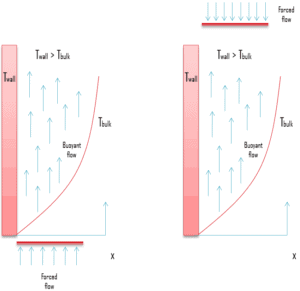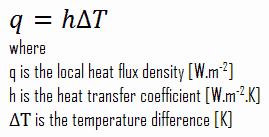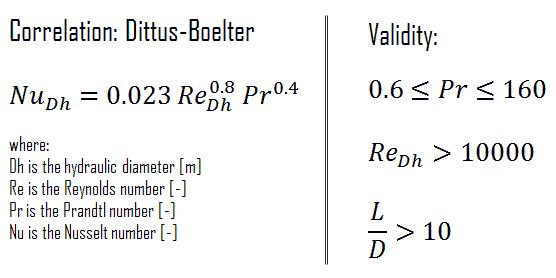Forced Convection
As was written, convection takes place through advection, diffusion or both. In this chapter we consider convection transfer in fluid flows that originate from an external forcing condition – forced convection.
Newton’s Law of Cooling
Despite the complexity of convection, the rate of convection heat transfer is observed to be proportional to the temperature difference and is conveniently expressed by Newton’s law of cooling, which states that:
The rate of heat loss of a body is directly proportional to the difference in the temperatures between the body and its surroundings provided the temperature difference is small and the nature of radiating surface remains same.
Note that, ΔT is given by the surface or wall temperature, Twall and the bulk temperature, T∞, which is the temperature of the fluid sufficiently far from the surface.
Forced Convection – Dittus-Boelter Equation
For fully developed (hydrodynamically and thermally) turbulent flow in a smooth circular tube, the local Nusselt number may be obtained from the well-known Dittus-Boelter equation. The DittusBoelter equation is easy to solve but is less accurate when there is a large temperature difference across the fluid and is less accurate for rough tubes (many commercial applications), since it is tailored to smooth tubes.
The Dittus-Boelter correlation may be used for small to moderate temperature differences, Twall – Tavg, with all properties evaluated at an averaged temperature Tavg.
For flows characterized by large property variations, the corrections (e.g. a viscosity correction factor μ/μwall) must be taken into account, for example, as Sieder and Tate recommend.
Combined Forced and Natural Convection
 As was written, convection takes place through advection, diffusion or both. In preceding chapters we considered convection transfer in fluid flows that originate from an external forcing condition – forced convection. In this chapter, we consider natural convection, where any fluid motion occurs by natural means such as buoyancy. In fact, there are flow regimes, in which we have to consider both forcing mechanisms. When flow velocities are low, natural convection will also contribute in addition to forced convection. Whether or not free convection is significant for heat transfer, it can be checked using the following criteria:
As was written, convection takes place through advection, diffusion or both. In preceding chapters we considered convection transfer in fluid flows that originate from an external forcing condition – forced convection. In this chapter, we consider natural convection, where any fluid motion occurs by natural means such as buoyancy. In fact, there are flow regimes, in which we have to consider both forcing mechanisms. When flow velocities are low, natural convection will also contribute in addition to forced convection. Whether or not free convection is significant for heat transfer, it can be checked using the following criteria:
- If Gr/Re2 >> 1 free convection prevails
- If Gr/Re2 << 1 forced convection prevails
- If Gr/Re2 ≈ 1 both should be considered
The effect of buoyancy on heat transfer in a forced flow is strongly influenced by the direction of the buoyancy force relative to that of the flow. Natural convection may help or hurt forced convection heat transfer, depending on the relative directions of buoyancy-induced and the forced convection motions. Three special cases that have been studied extensively correspond to buoyancy-induced and forced motions:
- Assisting flow. The buoyant motion is in the same direction as the forced motion.
- Opposing flow. The buoyant motion is in the opposite direction to the forced motion.
- Transverse flow. The buoyant motion is perpendicular to the forced motion.
It is obvious, in assisting and transverse flows, buoyancy enhances the rate of heat transfer associated with pure forced convection. On the other hand, in opposing flows, it decreases the rate of heat transfer. When determining the Nusselt number under combined natural and forced convection conditions, it is tempting to add the contributions of natural and forced convection in assisting flows and to subtract them in opposing flows:
Combined Forced and Natural Convection
For the specific geometry of interest, the Nusselt numbers Nuforced and Nunatural are determined from existing correlations for pure forced and natural (free) convection, respectively. The best correlation of data to experiments is often obtained for exponent n = 3, but it may vary between 3 and 4, depending on the geometry of the problem.
We hope, this article, Forced Convection, helps you. If so, give us a like in the sidebar. Main purpose of this website is to help the public to learn some interesting and important information about thermal engineering.

